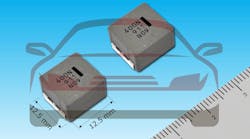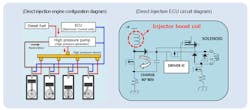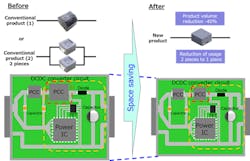Automotive ECU Inductor Touts Advances Across Multiple Parameters
It’s not easy being a passive component such as the humble inductor (also called a coil or choke, depending on how and where it’s used and fabricated). It doesn’t get much respect or attention as compared to active components and especially ICs. Still, passive components aren’t only necessary but essential, while their performance, design, and physical attributes usually have important implications for circuit performance, packaging, and manufacturability.
Those implications are made clear by a new inductor from Panasonic specifically targeting automotive engine control units (ECUs), which are increasingly located closer to the engine in what is a hot, vibration-intense, and generally nasty environment. The inductor in the dc-dc converter’s injector-boost circuitry must deal with high ripple currents that are always electrically and thermally stressful and challenging for long-term performance and reliability (Fig. 1).
Panasonic’s latest surface-mount automotive power chokes offer multiple benefits compared to their own predecessors:
- Cuts power loss in half (3 W versus 1.5 W) while doubling the withstand voltage from 60 V to 125 V, achieved through the use of new low-loss magnetic materials with higher withstand voltage.
- Shrinks the size by 40% and number of coils required to be incorporated into ECUs due to the improved performance, resulting in a smaller ECU.
- Eliminates the need for anti-vibration reinforcement measures as part of the mounting process, such as bonding-agent adhesives. The part accomplishes this via proprietary coil-winding and -forming technologies, which reduce the height of the terminal's pull-out position (contacts) to half compared to the company's conventional products (Fig. 2). The vibration resistance jumps significantly from a modest 5 g to a more substantial 30 g while the self-resonant frequency increases from 1300 Hz to 2500 Hz.
Using this inductor, a smaller ECU implementation is feasible, again when compared to using their previous-generation product (Fig. 3).
The table shows the top-tier specifications for the PCC-M1280MS, the first model in the family; other units will follow in 2021.
More information on the PCC-M1280MS and follow-on inductors, as well as construction and application insight, is available here.




